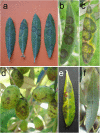Olive leaf spot caused by Venturia oleaginea: An updated review
- PMID: 36699830
- PMCID: PMC9868462
- DOI: 10.3389/fpls.2022.1061136
Olive leaf spot caused by Venturia oleaginea: An updated review
Abstract
Olive leaf spot (OLS) caused by Venturia oleaginea is widespread in all olive-growing areas and continents, where can cause severe yield losses. The disease is often underestimated for the difficulty to reveal early leaf symptoms and for the pathogen-induced phylloptosis, which creates the illusion of healthy and restored plants. The present review provide updated information on taxonomy, pathogen life style and cycle, epidemiology, diagnosis, and control. Application of copper-based fungicides is the main method to control OLS. However, the regulation 2009/1107 of the European Commission include these fungicides in the list of substances candidates for substitution. It is therefore urgent to find alternative control strategies especially for organic agriculture. Among new approaches/strategies for controlling OLS, promising results have been obtained using nanotechnology, endophytic microbes, and biostimulants.
Keywords: Fusicladium oleagineum; Olea europaea; Spilocaea oleagina; control; peacock’s eye disease.
Copyright © 2023 Buonaurio, Almadi, Famiani, Moretti, Agosteo and Schena.
Conflict of interest statement
The authors declare that the research was conducted in the absence of any commercial or financial relationships that could be construed as a potential conflict of interest.
Figures




Similar articles
-
Genome Sequence of Venturia oleaginea, the Causal Agent of Olive Leaf Scab.Mol Plant Microbe Interact. 2020 Sep;33(9):1095-1097. doi: 10.1094/MPMI-03-20-0070-A. Epub 2020 Jul 2. Mol Plant Microbe Interact. 2020. PMID: 32420795
-
Development and Application of a Quantitative PCR Detection Method to Quantify Venturia oleaginea in Asymptomatic Olive (Olea europaea) Leaves.Phytopathology. 2020 Mar;110(3):547-555. doi: 10.1094/PHYTO-07-19-0227-R. Epub 2020 Feb 4. Phytopathology. 2020. PMID: 31631805
-
No- or Low-Content Copper Compounds for Controlling Venturia oleaginea, the Causal Agent of Olive Leaf Spot Disease.Plants (Basel). 2024 Feb 22;13(5):600. doi: 10.3390/plants13050600. Plants (Basel). 2024. PMID: 38475447 Free PMC article.
-
Pseudomonas savastanoi pv. savastanoi: some like it knot.Mol Plant Pathol. 2012 Dec;13(9):998-1009. doi: 10.1111/j.1364-3703.2012.00816.x. Epub 2012 Jul 17. Mol Plant Pathol. 2012. PMID: 22805238 Free PMC article. Review.
-
Health Effects of Phenolic Compounds Found in Extra-Virgin Olive Oil, By-Products, and Leaf of Olea europaea L.Nutrients. 2019 Aug 1;11(8):1776. doi: 10.3390/nu11081776. Nutrients. 2019. PMID: 31374907 Free PMC article. Review.
Cited by
-
Innovations towards sustainable olive crop management: a new dawn by precision agriculture including endo-therapy.Front Plant Sci. 2023 Jun 6;14:1180632. doi: 10.3389/fpls.2023.1180632. eCollection 2023. Front Plant Sci. 2023. PMID: 37351220 Free PMC article. Review.
-
Dodine an effective alternative to copper for controlling Venturia oleaginea, the causal agent of pea-cock eye disease, in highly infected olive trees.Front Plant Sci. 2024 Mar 7;15:1369048. doi: 10.3389/fpls.2024.1369048. eCollection 2024. Front Plant Sci. 2024. PMID: 38516668 Free PMC article.
-
NGS transcriptomic analysis uncovers the possible resistance mechanisms of olive to Spilocea oleagina leaf spot infection.Front Plant Sci. 2023 Jul 17;14:1219580. doi: 10.3389/fpls.2023.1219580. eCollection 2023. Front Plant Sci. 2023. PMID: 37528972 Free PMC article.
-
Foliar Nutrition Strategies for Enhancing Phenolic and Amino Acid Content in Olive Leaves.Plants (Basel). 2024 Dec 16;13(24):3514. doi: 10.3390/plants13243514. Plants (Basel). 2024. PMID: 39771212 Free PMC article.
-
Nanopore-Sequencing Metabarcoding for Identification of Phytopathogenic and Endophytic Fungi in Olive (Olea europaea) Twigs.J Fungi (Basel). 2023 Nov 18;9(11):1119. doi: 10.3390/jof9111119. J Fungi (Basel). 2023. PMID: 37998924 Free PMC article.
References
-
- Adawi A., Jarrar S., Almadi L., Alkowni R., Gallo M., D’Onghia A. M., et al. . (2022). Effectiveness of low copper-containing chemicals against olive leaf spot disease caused by Venturia oleaginea . Agriculture 12 (3), 326. doi: 10.3390/agriculture12030326 - DOI
-
- Agosteo G., Schena L. (2011). “Olive leaf spot,” in Olive diseases and disorders. eds Schena L., et al. (Kerala, India: Research Signpost; ), 143–176.
-
- Agosteo G. E., Zappia R. (2007). Epidemiological study of olive scab in calabria. IOBC WPRS Bull. 30 (9), 233.
Publication types
LinkOut - more resources
Full Text Sources

